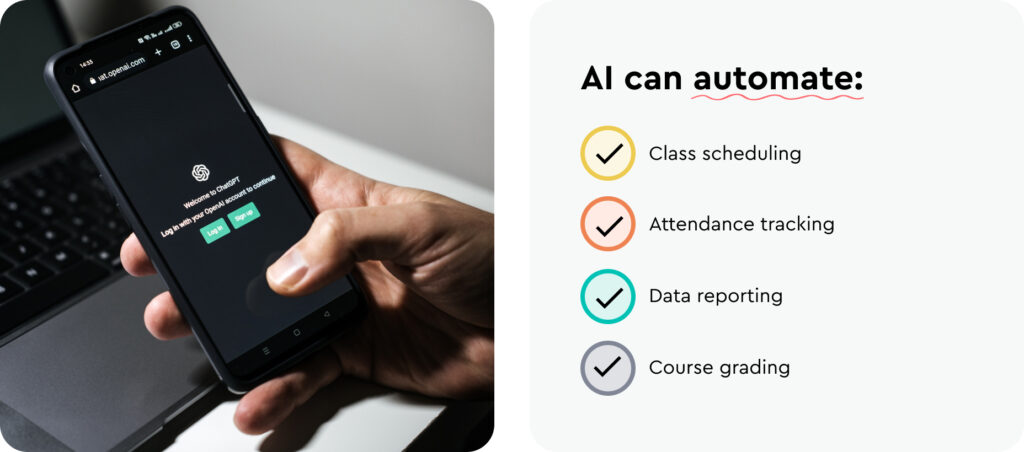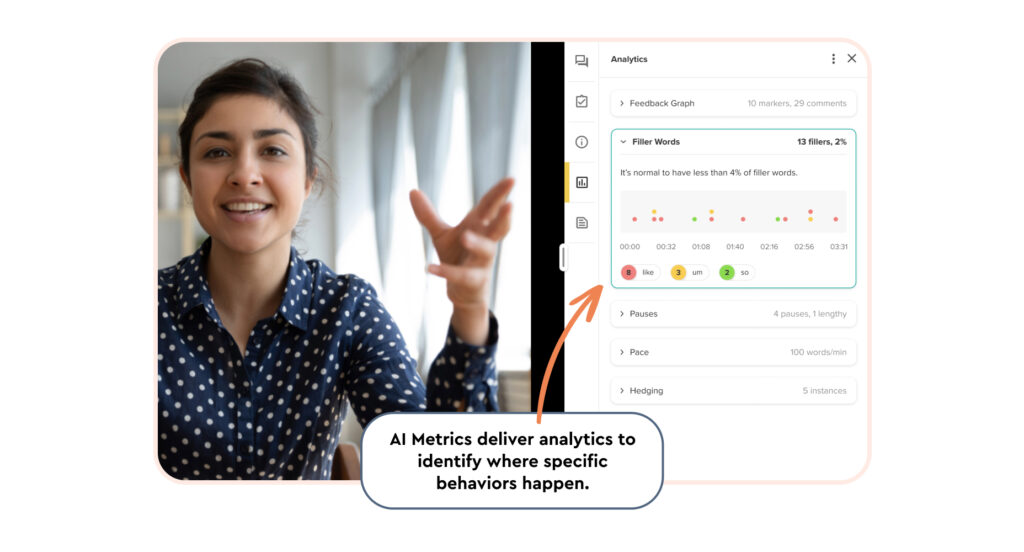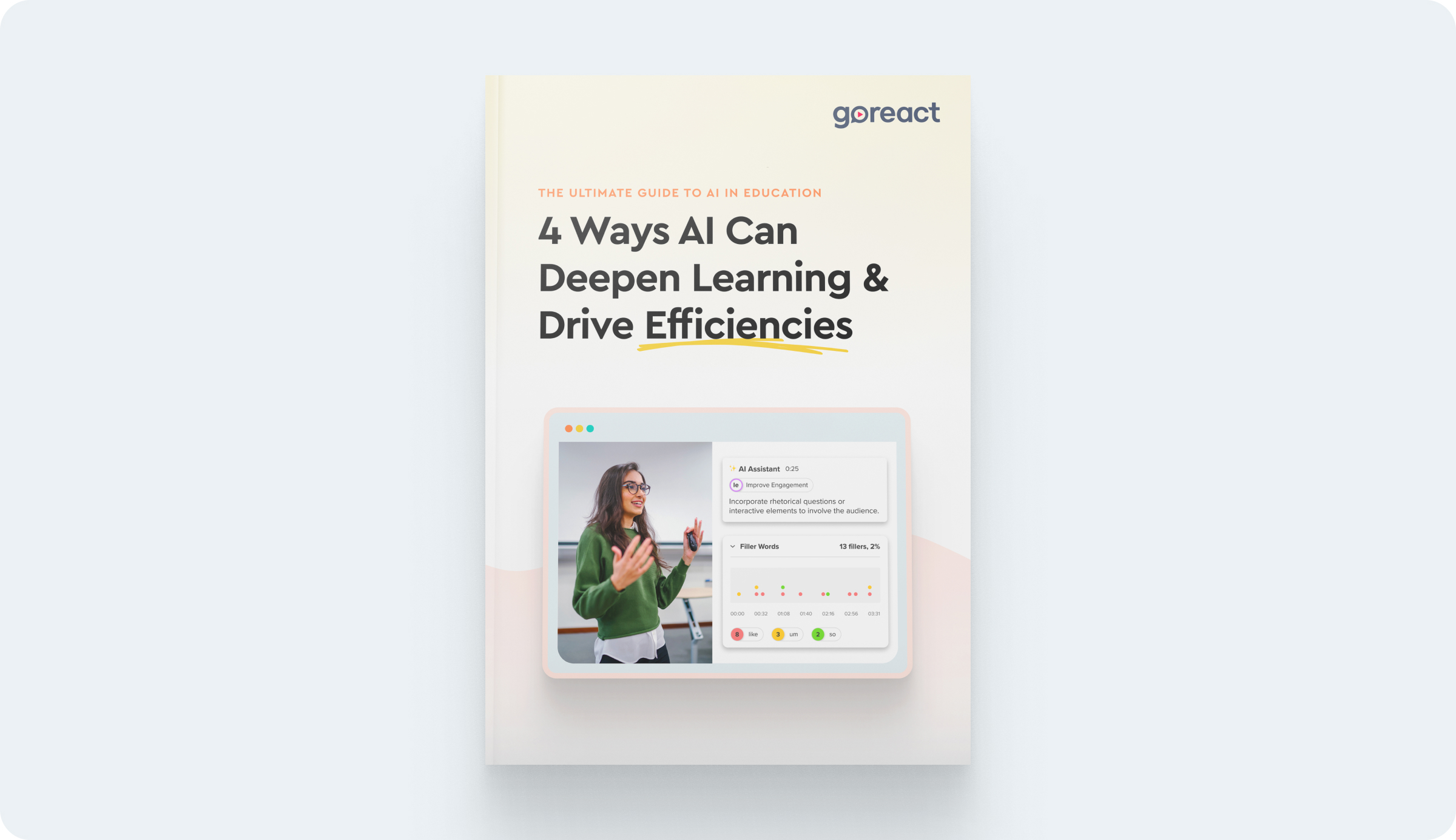Introduction
In a recent article, Bill Gates predicted that “entire industries will reorient around artificial intelligence.” And given all the AI buzz and the myriad of AI-powered products to enter the market over the last year, it seems he was right. The AI revolution is well underway, and its impacting nearly every sector — including higher education.
But Gates also hypothesized that “businesses will distinguish themselves by how well they use AI.” Given that AI is estimated to create 12 million more jobs by 2030 than it will replace and that AI could boost annual productivity by $4 trillion, there’s incredible opportunity for those educational institutions that can leverage AI to its full extent.
So far, higher education has been relatively focused on generative AI. But there are so many other ways to incorporate artificial intelligence into education. This guide will walk you through 4 ways instructors can use AI to deepen learning and drive efficiencies at their higher education institution.
1. AI Can Complement Instructors
No matter how advanced AI becomes, educators will remain irreplaceable. AI technology in education should serve as a complementary partner to the inherently human craft of teaching — helping educators manage their workloads and improve their instructional abilities.
Automate Mundane, Manual Work
For higher education instructors, long workdays are the norm. In fact, two-thirds of higher ed full-time staff typically work more than 40 hours each week. But AI can empower staff to work smarter.
By handling and automating the more repetitive, manual, and mundane tasks, AI enables educators to refocus their time on more valuable, strategic, and meaningful aspects of teaching and learning.
AI-powered systems can manage class schedules, allocate resources, and even predict the best times for classes based on historical data and student preferences.
AI teaching tools can also help automate the grading process, providing consistent and objective evaluations while reducing the time instructors spend on these tasks.

Provide Instructional Support
AI-driven platforms offer substantial support in instructional planning and delivery. By analyzing vast amounts of data, AI can provide insights into student performance, learning styles, and potential areas of difficulty. These insights enable educators to tailor their teaching strategies to meet the diverse needs of their students.
- Personalized Learning Plans: AI can help create individualized learning plans that adapt to each student’s progress and needs. For instance, platforms like Coursera and Khan Academy use AI to recommend courses and resources tailored to individual learners.
- Real-Time Analytics: AI tools can provide real-time analytics on student engagement and comprehension, allowing instructors to adjust their teaching methods promptly. This immediate feedback loop ensures that instructional interventions are timely and effective.
Identify Data-Driven Insights Faster
AI can analyze large datasets to uncover patterns and trends that would be difficult, if not impossible, for humans to identify. These insights can inform instructional strategies, helping educators focus on areas that will have the most significant impact on student learning.
- Uncovering Learning Gaps: AI tools for teachers can highlight areas where students are struggling, allowing educators to address these gaps promptly. For example, platforms like DreamBox use AI in education to adapt math lessons in real-time based on student performance, ensuring that each learner receives the appropriate level of challenge.
- Improving Course Content: By analyzing student feedback and performance data, AI can suggest improvements to course materials, ensuring that content remains relevant and engaging.

Facilitate Deeper Learning
AI-powered tools can also facilitate deeper learning experiences by providing personalized support and feedback. This approach helps students develop a more profound understanding of the material and enhances their overall learning experience.
- Interactive Learning Environments: AI can create interactive and immersive learning environments that engage students in active learning. For example, virtual reality (VR) platforms like zSpace use AI to create realistic simulations that allow students to explore complex concepts in a hands-on manner.
- Personalized Feedback: AI can streamline the feedback process by automating repetitive feedback, allowing instructors to focus on delivering more personalized and detailed insights. GoReact, for instance, uses AI Markers and Comments to automate the delivery of common feedback on video assignments. This provides students with initial insights quickly, freeing up instructors to offer more specific and actionable feedback tailored to each student’s unique needs and performance.
2. AI Can Enhance Skill Development
As instructors in higher education, a key priority is to prepare students for successful careers. But with a whopping 56% of U.S. employers reporting that it’s difficult to find workers who possess the specific skills needed to excel in their roles, there’s clearly a disconnect between skills prioritized in educational curricula and those required by employers. AI can help bridge this gap by transforming skill development in higher education, addressing the skills crisis, and preparing students for the evolving job market.
Using AI to Improve Human Skills
Before the advent of AI, there was already a significant skills gap of $1.6 trillion in the U.S. workforce. Now, the stakes are even higher as AI changes the types of skills students need to succeed. Emphasis is shifting towards durable or innately “human” skills that AI cannot easily replicate. But certain AI-powered tools offer new ways students and teachers can enhance these uniquely human skills.
- Critical Thinking and Problem-Solving: AI can support the development of critical thinking and problem-solving skills by providing challenging scenarios and simulations. For example, AI-powered platforms like Labster offer virtual labs where learners can conduct experiments and solve problems in a controlled environment.
- Communication and Collaboration: As AI takes over routine tasks, the ability to communicate effectively and work collaboratively becomes even more critical. Tools like GoReact enable students and teachers to practice and refine their communication and teamwork skills through video assignments and peer feedback.
- Creativity and Innovation: AI can augment the creative process by offering new tools and mediums for expression, but the intrinsic human ability to innovate and create original content remains invaluable. Platforms like Canva and Adobe Spark leverage AI to assist users in design, enabling them to bring their creative ideas to life more efficiently.
- Emotional Intelligence and Empathy: Amid the prevalence of AI, the ability to understand and respond to human emotions becomes even more significant. Training programs that use AI simulations can help students and educators develop empathy and emotional intelligence by exposing them to diverse scenarios and perspectives, enhancing their ability to connect with others on a human level.
- Presentation Skills: Tools like GoReact enable learners to record and review their presentations, receiving time-stamped feedback from instructors and peers. This process helps students identify areas for improvement and refine their communication competencies.
- Writing Skills: AI-powered writing assistants like Grammarly provide real-time feedback on grammar, style, and clarity, helping learners improve their writing skills. These tools can also offer suggestions for enhancing the structure and clarity of written assignments.

Opportunities for Students
Incorporating AI in education empowers students by providing interactive and sometimes immersive opportunities for skill development that are tailored to their individual needs, goals, and interests.
- Self-Directed Learning: AI allows students to take control of their learning journey by providing personalized resources and feedback. For example, adaptive learning platforms like Knewton use AI to recommend learning activities based on each student’s progress and preferences.
- Practice and Mastery: AI tools offer more opportunities for practice and mastery of skills. For instance, language learning apps like Duolingo use AI to provide personalized lessons and practice exercises, helping students achieve fluency more quickly.
- Personalized Education: AI can tailor educational experiences to individual learning styles and paces, ensuring that all students have the support they need to succeed. Platforms like Smart Sparrow use AI to create adaptive learning pathways that adjust to each student’s needs.
- Virtual Labs: AI-powered virtual labs, like those offered by Labster, provide students with hands-on experience in conducting experiments and solving problems. These simulations help students develop practical skills and deepen their understanding of complex scientific concepts.
- Adaptive Learning: Using AI in education can personalize STEM experiences by adapting lessons and exercises to each student’s skill level and progress. Platforms like ALEKS use AI to create individualized learning paths in subjects like math and chemistry, ensuring that students receive the support they need to succeed.
Opportunities for Teachers
AI education tools can significantly enhance educator preparation and development by offering innovative tools and resources that empower them to refine their skills and improve their instructional practices.
- Simulated Teaching Environments: AI-powered platforms like Mursion use virtual reality to create realistic teaching simulations, allowing pre-service teachers to practice their skills in a controlled setting. These simulations can provide real-time feedback on teaching strategies and classroom management techniques.
- Personalized Feedback: AI can analyze teaching performance and provide personalized feedback to help educators improve their practice. Tools like GoReact allow instructors to review and critique teaching videos, providing specific and actionable feedback.
- Professional Development: AI-driven platforms can personalize professional development for educators, recommending courses and resources based on individual teaching styles and areas for improvement. This targeted approach ensures that teachers receive the most relevant and effective training.
- Classroom Analytics: AI tools can track classroom interactions and student engagement, offering insights that help teachers understand their impact and adjust their methods accordingly. This data-driven approach supports continuous improvement in teaching practices.
3. AI Can Humanize and Personalize Learning
Classrooms, even virtual ones, are unique places where humans can create incredible connections. Students can have valuable interactions with their peers, while teachers can converse with students on a more personal level.
AI simply cannot replace these very interpersonal relationships. But it can help facilitate more meaningful, personalized conversations to deepen connections and create incredible learning experiences for students and educators alike.

Create More Meaningful Interactions Among Students
AI-powered tools can significantly enhance student interactions by creating more opportunities to connect — helping them develop important interpersonal skills while learning from one another.
- Enhanced Collaboration: AI in education can facilitate collaboration by providing platforms that allow students to work together seamlessly, even when they’re not physically together. Tools like Microsoft Teams and Google Classroom use AI to organize group projects, track contributions, and suggest ways to improve group dynamics. This allows students to spend in-person class time focusing on activities best nurtured through direct interaction, such as group projects and presentations.
- Peer Feedback: AI-powered platforms enable students to give and receive feedback from their peers. This process not only improves their own work but also enhances their ability to evaluate and constructively critique others. Platforms like Peergrade facilitate this by automating the feedback process and ensuring that it is fair and consistent. Such tools help students develop critical thinking and communication skills, which are best honed through practice and interaction.
- Engagement Analytics: AI can monitor student engagement in real-time, identifying when students are most active and involved. This data helps educators understand how students interact with the material and with each other, allowing them to make adjustments that foster better engagement and collaboration.
Give Educators New Ways to Connect With Students
AI tools empower educators to focus on what they do best: teaching and mentoring. By leveraging AI in education, instructors can enhance their interactions with students, providing the personalized attention and support that drives academic success and fosters strong, lasting relationships.
- Personalized Learning Pathways: AI can create individualized learning plans that adapt to each student’s needs and progress. This personalization helps educators identify the best approaches for each student and tailor their interactions accordingly. Platforms like DreamBox and Smart Sparrow offer such capabilities, ensuring that every student receives a customized educational experience.
- Real-Time Feedback: AI tools provide real-time insights into student performance, allowing educators to offer immediate and relevant feedback. This timely intervention helps address issues before they become significant problems. GoReact, for instance, allows educators to give instant, time-coded feedback on video assignments, facilitating prompt and effective communication. This enables faculty to focus more on the human aspects of teaching, engaging in deeper conversations and providing more personalized feedback.
- Virtual Office Hours: AI can assist in managing virtual office hours by scheduling appointments, answering frequently asked questions, and providing resources. This support allows educators to maximize their time with students, focusing on deeper, more meaningful interactions. AI chatbots and virtual assistants can handle routine inquiries, freeing up time for more personalized discussions.
By leveraging AI to support these areas, educators can create a more personalized and engaging learning environment that deepens human connections for students and teachers.
4. AI + Video Can Deliver Incredible Value
Combining video technology with AI offers significant benefits for education, enhancing personalized feedback, providing time-saving insights, and enabling authentic assessments.
Personalized Feedback
AI-enhanced video tools like GoReact automate the delivery of repetitive feedback, allowing instructors to focus on providing personalized, time-stamped insights on student videos. This approach fosters deeper learning and skill development by ensuring that students receive both immediate initial feedback and detailed, tailored guidance from their instructors.
- Detailed Analysis: AI can analyze video recordings and provide immediate feedback on the essential elements of communication, including pacing, filler words, hedging words, and pauses. This level of analysis helps students quickly understand their strengths and areas for improvement and saves instructors time.
- Actionable Insights: Personalized feedback from AI tools provides students with specific and actionable insights that they can use to improve their performance. This targeted approach helps students make meaningful progress in their skill development and frees up educator time for more impactful instruction.

Time-Saving Insights
AI-driven analytics can identify trends and patterns in student performance in videos, allowing educators to make data-informed decisions that improve instructional effectiveness.
- Performance Metrics: AI-enhanced video tools can track and analyze performance metrics over time, providing educators with valuable insights into student progress. These metrics can inform instructional strategies and help educators identify areas where additional support may be needed.
- Efficiency Gains: By automating data analysis, AI-enhanced video tools save educators time and effort, allowing them to focus on direct student interactions and personalized instruction. This efficiency gain enhances the overall effectiveness of the teaching and learning process.

Authentic Assessments
Video assessments provide a more authentic evaluation of student skills, particularly in areas like communication and presentation.
- Real-World Applications: Video assessments allow students to demonstrate their skills in realistic scenarios, providing a more accurate measure of their abilities. For example, students can record and submit presentations, performances, or demonstrations, allowing instructors to evaluate their skills in context.
- Holistic Evaluation: AI tools can provide a holistic evaluation of student performance by analyzing multiple aspects of their work. This comprehensive approach ensures that students receive a well-rounded assessment that reflects their true capabilities.

The Future of AI in Education
The integration of AI in higher education is not just about keeping pace with technological advancements; it’s about driving deeper skills-based learning and operational efficiencies. By adopting and implementing AI-powered tools such as GoReact, higher education institutions can improve instruction, enhance skill development, personalize learning, and ultimately better prepare students for the future.
Discover the transformative power of the GoReact AI Assistant
Learn more about how GoReact and other AI tools can enhance your institution’s teaching and learning practices. Join us in harnessing the power of AI to drive deeper learning and operational efficiencies, and position your institution as a leader in the future of education.







